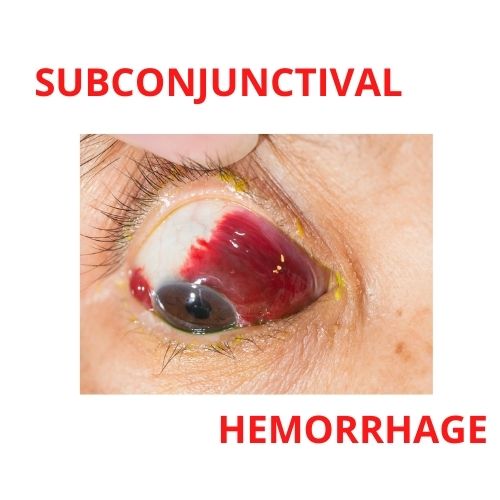What is a Subconjunctival Hemorrhage


A subconjunctival hemorrhage is bleeding in the eye, specifically the white part of the eye. The hemorrhage can be a tiny speck of redness or a large bright red area. It is usually harmless and is the result of broken blood vessels and it will heal on its own without any treatment.
Causes of Subconjunctival Hemorrhage
The conjunctiva of the eye is clear tissue that covers the sclera. Beneath them there are many tiny blood vessels and they are fragile and can break and leak blood. Forcefully coughing, sneezing, or straining such as doing heavy lifting are common causes of broken blood vessels in the eye. Even rubbing your eye too roughly can break blood vessels in the eye.
Sometimes people wake up and see they have a subconjunctival hemorrhage, and this is often due to hitting or forcefully rubbing the eye during sleep. Trauma or injury to the eye can also break blood vessels. If your eye was injured, you may want to visit your eye doctor so the inside of your eye can be examined to make sure there aren’t other injuries.
Less common causes are diabetes, high blood pressure, or medications that make you bleed more easily, such as aspirin, or blood thinners like Coumadin. Only rarely is subconjunctival hemorrhage caused by a blood clotting disorder or a disease. However, if you have had subconjunctival hemorrhage more than twice in a year you should get a complete physical to rule out any underlying medical condition.
Treatment
A subconjunctival hemorrhage will clear up on its own and does not require treatment. It usually causes no pain or vision changes, but occasionally there may be minor itching of the eye or a scratchy sensation when blinking. Artificial teas can be used to relieve the itching and irritation. Avoid rubbing your eye if it is itchy.
If you are concerned about blood in your eye, schedule an eye exam to ensure that your eye is intact and there are no other injuries inside the eye.
Healing
Visible blood that was trapped between the sclera and the clear conjunctival covering of the eye will be slowly reabsorbed. A large subconjunctival hemorrhage can take up to two or three weeks to fade. During that time the redness may change to orange and then to pink before your eye returns to white. It will fade in a way similar to the way bruises on your skin fade.
If you would like to make an appointment, call us 609.877.2800 or EMail us.
Gregory Scimeca, M.D.
Ophthalmologist and Medical Director
The Eye Professionals
Our Locations
- 225 Sunset Road | Willingboro, NJ | 08046
- 423 Clements Bridge Road | Barrington, NJ | 08007
- 1802 Haddonfield Berlin Road | Cherry Hill, NJ | 08003
- 1205 High Street | Millville, NJ | 08332
- 711 E. Main St. | Moorestown, NJ | 08057
- 950 Town Center Dr. | Suite B-100 | Langhorne, PA | 19047
